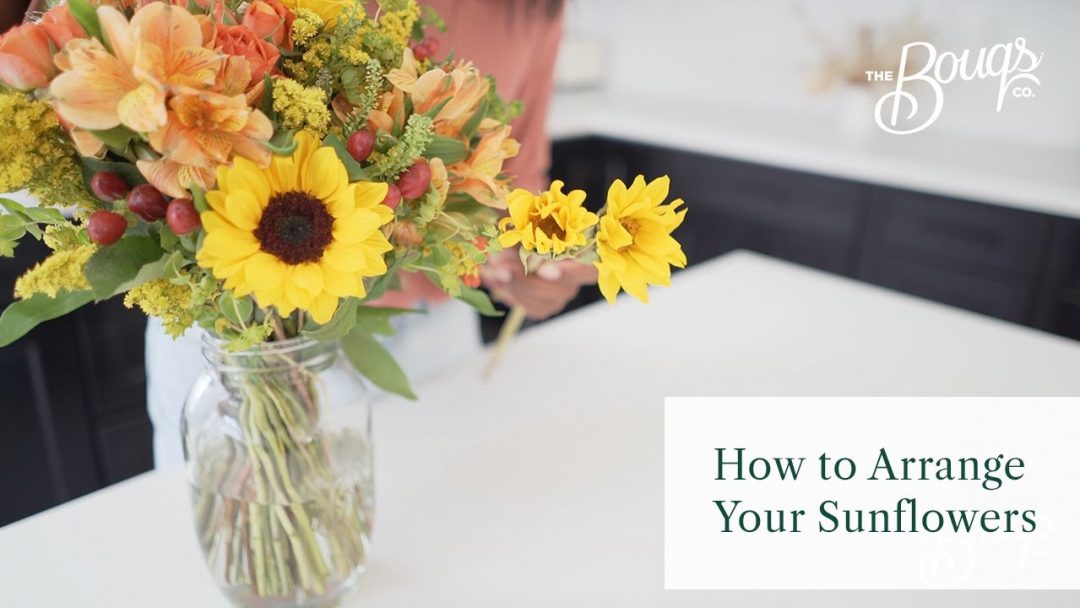Did someone say sunflowers? Just the mention of these bright blooms uplifts a room, and a bouquet of these beauties can brighten even the darkest of days. To help you make the most of these beauties, we’re going to let you in on some sunflower arranging tips.
Sunflower Facts
You already know these bright blooms add some cheer to any bouquet, but did you know these flowers are as cool as they are beautiful? There are all sorts of facts about sunflowers that will make you love these flowers even more.
Not only do these flowers look like little suns, but they’re also experts at soaking up some rays. Sunflowers move throughout the day to keep their blooms facing the sun, so don’t you dare tell them they need a beach umbrella. If you drive by a field of sunflowers in the morning and again in the evening, you’ll find they’ve all rotated! This phenomenon is called heliotropism.
Sunflowers can also grow tall. Very tall. While the height will differ between varieties, one plant has grown over 30 feet!
Time for one more little secret. Each sunflower bloom contains hundreds of individual flowers! The middle of the bloom is composed of tiny flowers called disc flowers. And you know those things you probably call petals? They’re actually ray flowers!
Types of Sunflowers
When you think of sunflowers, you probably imagine bright yellow flowers that sprawl across fields or brighten up your home. While these blooms are undoubtedly gorgeous, there are over 70 species of sunflowers and hundreds of varieties. That means these flowers come in all sorts of colors, shapes, and sizes.
Some new varieties on the market add flair with pink, red, and maroon petals. And if you’re really looking for something wild, you can look for blooms with shaggy petals that resemble fringe.
There are two main types of sunflowers: branching and single-stem. As the names suggest, branching plants produce multiple blooms on branching stems while single-stem varieties produce one bloom on a single stem. Flower farmers typically grow single-stem sunflowers since they’re easier to harvest.
Unpacking Your Sunflowers
Once your sunflowers arrive, you’ll need to get to work unpacking them. As you take the flowers out of the box, you’ll discover a few unique features.
Sunflower stems feel fuzzy, but this is nothing to worry about. If these little bristles irritate your hands, you can always wear gloves to arrange your flowers.
You’ll notice that your sunflowers arrive in bud form rather than the open form we know and love. But don’t fear! Bud form means you’ll get to enjoy your flowers for as long as possible. Plus, you can watch the flowers open up over time.
Sunflower Care
Another thing to remember about sunflowers is that they’re very thirsty flowers! Providing enough water is a crucial part of sunflower care. When they arrive, it’s a good idea to give them a drink ASAP. Simply place the stems in a cup or vase of room temperature water until you’re ready to begin arranging.
Since these flowers drink so much, you’ll also want to keep an eye on your vase’s water level. And make sure to change the water every other day to prevent the buildup of harmful bacteria.
The Natural Aesthetic of Sunflowers
The sunflower’s central bloom is actually made up of tiny flowers in a pattern. It may look like a solid, circular surface from afar. But up close those inner rings of flowers are really an intricate natural design of small blooms. It’s basically a feng shui bedroom arranged in bee heaven.
Flowers in the center of the bloom grow in a mathematical pattern called the golden ratio (1.61803…). This natural pattern shows up all over the place in nature including pinecones, galaxies, and flowers in the sunflower family-like daisies and poms. Outside of sunflower arrangements, this natural design allows them to complement a broad range of unique flower bouquets.
Flower Pairings
Because of their natural growth pattern, bright color, and size, sunflower arrangements often include blooms that add contrast or transition in color or shape. Blooms like roses add an offset pattern, sharing center stage with the sunflowers. Blooms in the same flower family-like daisies add volume while focusing on the beauty of the sunflower. That’s why the nominees for best-supporting flowers are smaller like asters and chrysanthemums. Sunflowers simply can’t be “eclipsed” by other flowers, it’s in their nature.
Time to Arrange Your Sunflower Bouquet

Now that you’ve unpacked your sunflowers, it’s time to get them looking pretty! Before you start arranging your blooms, give every stem a fresh trim. Use a sharp pair of shears to cut each stem at a 45º angle.
If you’re designing a mixed arrangement, it’s best to put sunflowers in at the end. These large blooms love to serve as a focal flower rather than a supporting cast member. By placing them in last, you’ll give them all the room they need to blossom.
You’ll likely have a few sunflowers in your arrangement. Rather than placing all the blooms in the same area, spread them throughout your bouquet so every angle has a bit of cheer.
If you’re designing a bouquet filled with sunflowers, you don’t have to spend much time worrying about proper placement. Simply give each stem a fresh cut and plop it into your vase. Once you see how your arrangement looks, it’s time to tinker with stem height. Remove a few flowers and give them a little trim and place them back into the vase. This will help form a nice base so your sunflowers look bright and voluminous rather than flat.
Let the Sun Shine
That’s it! Go ahead and grab some of the cheerful flowers and get to work designing a winning bouquet.
Shop All



